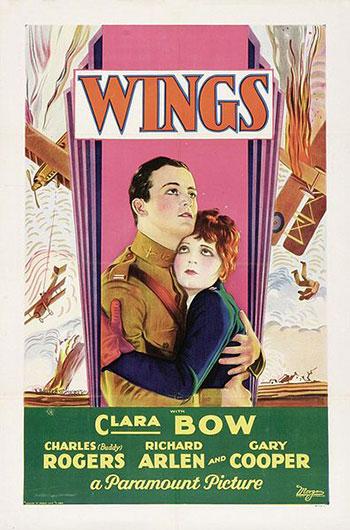On August 31st, acclaimed composer and pianist Andrew E. Simpson will perform the world premiere of his original score for William Wellman's riveting story of love and tragedy, Wings (144 minutes, silent; 1927). The program is jointly presented by American Art and the National Portrait Gallery. Free tickets available in the G Street lobby at 2:30 p.m.; limit two per person. Alli Jessing, Auditorium Program Coordinator for both museums fills us in on the history of music and silent films.
Trailer for Wings, showing at the Smithsonian American Art Museum and the National Portrait Gallery August 31st.
Silent films are enjoying a resurgence of popularity in culture today, as advances in preservation and restoration technology have enabled film conservators to restore decaying film stock. Silent films, like other art forms, are often interpreted through symbolism and visual cues in addition to the narrative. These clues can be an expression, a featured object in the frame, a gesture, or through close-up, detailed shots of things the director wanted to make sure we noticed, or even in how a scene is lit. These clues can also come in the form of music.
Between the 1890s and the 1920s, silent films were traditionally accompanied by a pianist, organist, or sometimes an entire orchestra right in the theater. They played something called photoplay music: a mix of original, popular, classical and repertory music that matched the tones and events in the film. Musicians also improvised. A theater would have a library of photoplay music, and base their music choices on cue sheets provided by the film studios. This provided the pianist or orchestra with what something like a mix-tape: a compilation of music that suited the emotions and narrative of the story unfolding before us. While some films did have scores written specifically for them, more often than not the scores varied by theater, their accompanists, and their music library. This less-than-consistent approach to film screenings made each one a unique experience. You might see the same film twice, but you'd never hear it the same way.
Music was the essential thread that tied the visuals to the appropriate emotional context: a thunderous bass section might have underscored the significance of dark storm clouds rolling in on the horizon, while a lighter, fanciful melody would set up a laugh when someone took a pie to the face. The introduction of a hero would be signaled with a rising tide of chimes, while the arrival of a villain (who may or may not be there to tie a wide eyed maiden to the railroad tracks) would be accompanied with a darker, ominous score. With the advent of synchronous sound and the development of amplification equipment, these live "cinema-concerts" soon became a thing of the past. But they live again at the Smithsonian American Art Museum and the National Portrait Gallery!
This Saturday, August 31st, the Smithsonian American Art Museum and National Portrait Gallery will be hosting a special cineconcert screening of Wings, the silent film classic starring Clara Bow that also features an early appearance by silver screen legend Gary Cooper. This story of two friends who fall in love with the same woman, but must leave her behind when they enlist as combat pilots during World War I, won the very first Academy Award® for Best Picture in 1927 (the only other silent film to achieve this honor was The Artist in 2011). Despite this honor, the film was considered lost for a number of years. When a complete print was finally discovered, it was duplicated and rereleased. The film has enjoyed a resurgence of interest of late, and has recently been restored.
The original version of Wings featured an orchestral score by J. S. Zamecnik. At our special screening, however, we are pleased to feature acclaimed pianist and composer Andrew E. Simpson, who will premier his new original score for the film. Simpson is co-founder of the Snark Ensemble, a group devoted to creating and performing new scores for silent film, theater, and dance. He is also the Resident Film Accompanist for the National Gallery of Art and House Accompanist for the Library of Congress' Mt. Pony Theater. He has performed his acclaimed original film scores locally at the Kennedy Center in Washington, D.C. and the AFI Silver Theater in Silver Spring, nationally at the New York Public Library at Lincoln Center and the J. Paul Getty Villa in Los Angeles, and internationally at the Giornate del Cinema Muto in Pordenone, Italy and the Sala Cecelia Meireles in Rio de Janeiro, Brazil. Simpons is professor and head of the division of Theory and Composition at the Benjamin T. Rome School of Music of The Catholic University of America in Washington, D.C.



















